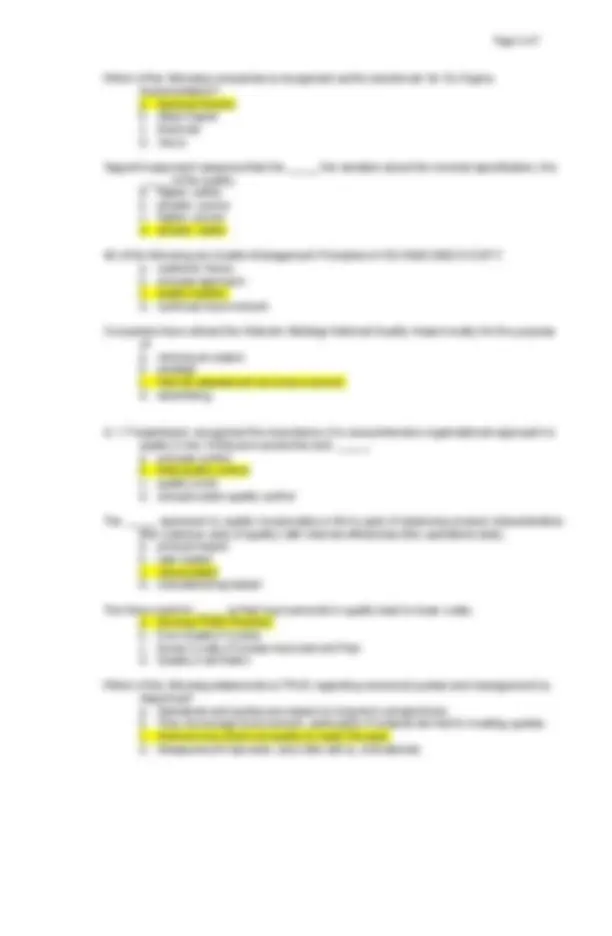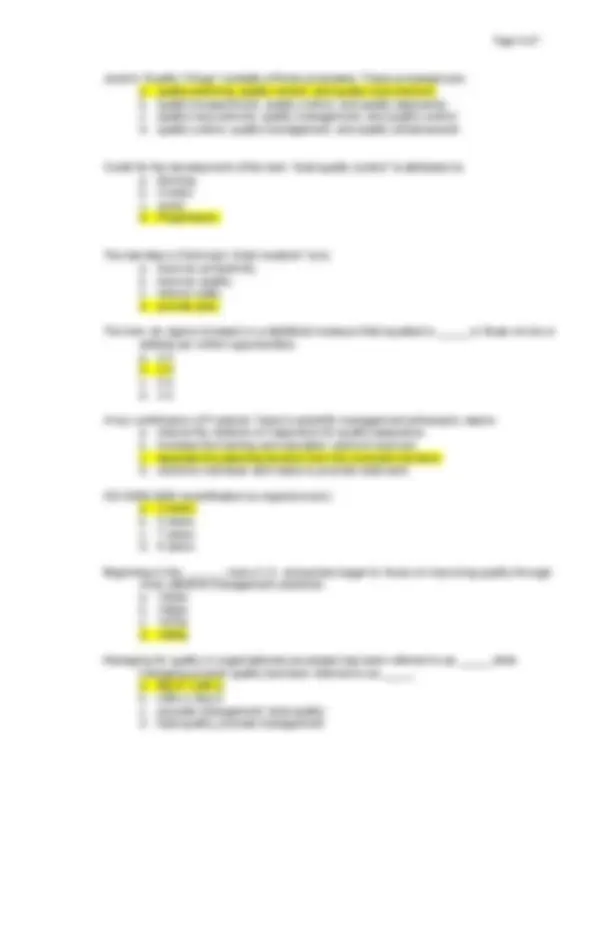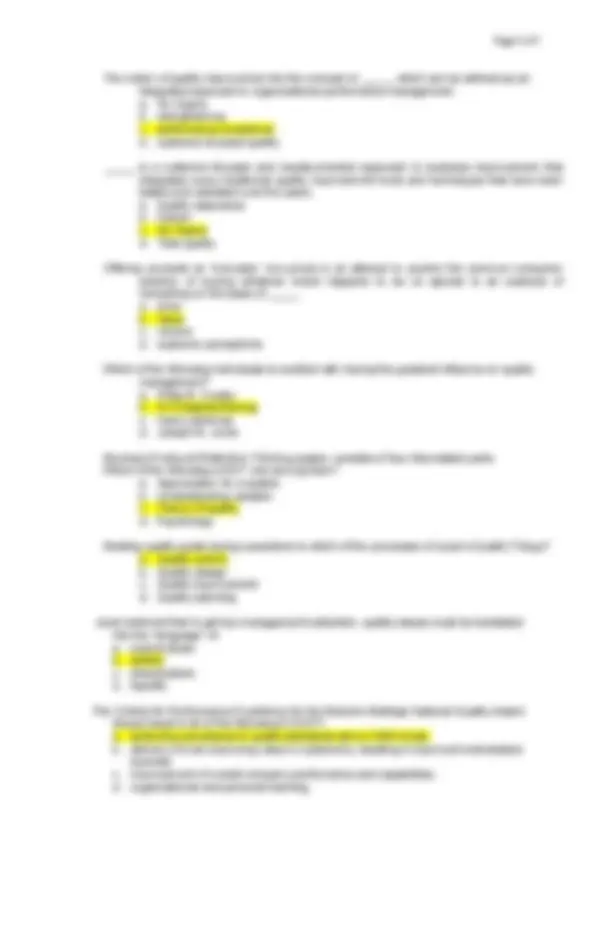





Study with the several resources on Docsity

Earn points by helping other students or get them with a premium plan


Prepare for your exams
Study with the several resources on Docsity

Earn points to download
Earn points by helping other students or get them with a premium plan
Community
Ask the community for help and clear up your study doubts
Discover the best universities in your country according to Docsity users
Free resources
Download our free guides on studying techniques, anxiety management strategies, and thesis advice from Docsity tutors
An in-depth exploration of quality management principles, concepts, and historical developments. It covers topics such as control charts, quality priorities in post-wwii manufacturing, the evolution of quality during the middle ages, and the deming prize. The document also delves into total quality management, performance excellence, quality definitions, and the role of psychology at work. Notable figures like deming, crosby, juran, and taguchi are discussed, along with quality management principles of iso 9000:2000 and the malcolm baldrige national quality award.
Typology: Exams
1 / 7

This page cannot be seen from the preview
Don't miss anything!




_____ is credited with developing control charts. a. Eli Whitney b. Frederick W. Taylor c. Walter Shewhart d. W. Edwards Deming Which of the following was the top priority of U.S. manufacturing in the time period immediately following World War II? a. Quality b. Production c. Continuous improvement d. Just-in-time manufacturing During the Middle Ages, quality was built into the final product. This approach to quality was lost with the advent of: a. engineering schools. b. craft guilds. c. automation. d. the Industrial Revolution. The following represent significant influences that brought on the “quality revolution” in the United States EXCEPT the: a. loss of national competitiveness. b. findings of the American Customer Satisfaction Index (ACSI). c. popularity of “Made in Japan” products in the country. d. broadcast of the NBC special program, If Japan Can, Why Can’t We? In 1989, _____ was the first non-Japanese company to be awarded Japan’s coveted Deming Prize for quality. a. Florida Power and Light b. AT&T Power Systems c. Motorola Inc. d. General Electric
The term _____ was developed by the U.S. Naval Air Systems Command to describe its Japanese-style approach to quality improvement that is based on participation of all members of an organization in improving goods, services, and the organizational culture. a. total quality management b. companywide quality control c. quality circle d. process control Performance excellence results in all of the following EXCEPT: a. delivery of ever-improving value to customers and stakeholders. b. improvement of overall organizational effectiveness and capabilities. c. organizational and personal learning. d. improved lateral communication. One common notion of quality, often used by consumers, is that it is _____ superiority or excellence. a. contrasted to b. parallel to c. synonymous to d. confused with The _____ definition of quality is that it is a function of a specific, measurable variable and that differences in quality reflect differences in quantity of some product attribute. a. manufacturing-based b. product-based c. value-based d. user-based According to Deming, product or a service possesses quality if it: a. conforms to standards and provides customer satisfaction. b. helps somebody and enjoys a good and sustainable market. c. matches or exceeds the standards set by the competition. d. incorporates quality in its design, production, and delivery. The last part of the Deming’s Profound Reflective Thinking, psychology, provides an understanding of human behavior. Which of the following is NOT true regarding psychology at work? a. People differ from one another. b. People are born with a need for love and esteem in their relationships. c. Fear motivates people thus helping the system to reach its full potential. d. Pay is not a motivator. The quality definition of “fitness for use” is associated with: a. Shewhart. b. Deming. c. Crosby. d. Juran. Which of the following represents an activity classified by Juran under “quality planning?” a. Inspection b. Process design c. Statistical process control d. Waste reduction teams
Juran’s “Quality Trilogy” consists of three processes. These processes are: a. quality planning, quality control, and quality improvement. b. quality measurement, quality control, and quality assurance. c. quality improvement, quality management, and quality control. d. quality control, quality management, and quality enhancement. Credit for the development of the term “total quality control” is attributed to: a. Deming. b. Crosby. c. Juran. d. Feigenbaum. The last step in Deming’s “chain reaction” is to: a. improve productivity. b. improve quality. c. reduce costs. d. provide jobs. The term six sigma is based on a statistical measure that equates to _____ or fewer errors or defects per million opportunities. a. 4. b. 3. c. 5. d. 2. A key contribution of Frederick Taylor’s scientific management philosophy was to: a. reduce the reliance on inspectors for quality assurance. b. increase the training and education workers received. c. separate the planning function from the execution function. d. combine individual work tasks to promote teamwork. ISO 9000:2000 recertification is required every: a. 3 years. b. 5 years. c. 7 years. d. 8 years. Beginning in the ______, many U.S. companies began to focus on improving quality through more effective management practices. a. 1950s b. 1960s c. 1970s d. 1980s Managing for quality in organizational processes has been referred to as _____ while managing product quality has been referred to as _____. a. Big Q, Little q b. Little q, Big Q c. process management, total quality d. total quality, process management
The notion of quality has evolved into the concept of _____, which can be defined as an integrated approach to organizational performance management. a. Six Sigma b. reengineering c. performance excellence d. customer-focused quality _____ is a customer-focused and results-oriented approach to business improvement that integrates many traditional quality improvement tools and techniques that have been tested and validated over the years. a. Quality assurance b. Kaizen c. Six Sigma d. Total quality Offering products at “everyday” low prices in an attempt to counter the common consumer practice of buying whatever brand happens to be on special is an example of competing on the basis of _____. a. price b. value c. volume d. customer perceptions Which of the following individuals is credited with having the greatest influence on quality management? a. Philip B. Crosby b. W. Edwards Deming c. Kaoru Ishikawa d. Joseph M. Juran Deming’s Profound Reflective Thinking system consists of four interrelated parts. Which of the following is NOT one among them? a. Appreciation for a system b. Understanding variation c. Theory of quality d. Psychology Meeting quality goals during operations is which of the processes of Juran’s Quality Trilogy? a. Quality control b. Quality design c. Quality improvement d. Quality planning Juran believed that to get top management’s attention, quality issues must be translated into the “language” of: a. market share b. dollars c. shareholders d. liquidity The Criteria for Performance Excellence for the Malcolm Baldrige National Quality Award should result in all of the following EXCEPT: a. achieving compliance to quality standards set by CMM levels. b. delivery of ever-improving value to customers, resulting in improved marketplace success. c. improvement of overall company performance and capabilities. d. organizational and personal learning.
The change in society’s attitude from “let the buyer beware” to “let the producer beware” was fueled by all the following factors EXCEPT: a. government safety regulations. b. product recalls. c. popularity of TQM as a quality tool. d. the rapid increase in product-liability judgments. Which of the following is most appropriate in describing the quality efforts undertaken with the scientific management philosophy? a. Defect prevention was emphasized. b. Quality circles were extensively used. c. Use of inspection was wide-spread. d. Quality was every worker’s responsibility. The creation of separate quality departments in the early 1900s caused: a. indifference to quality among workers and their managers. b. upper management to be more knowledgeable about quality. c. production quality to substantially improve. d. production efficiency to decline. The two U.S. consultants that worked with the Japanese to integrate quality throughout their organizations in the 1950s were: a. Juran and Crosby. b. Deming and Crosby. c. Deming and Juran. d. Juran and Crosby. In the 1950s, the Japanese integrated quality throughout their organizations and developed a culture of _____ sometimes referred to by the Japanese term kaizen. a. consumer orientation b. internal competition c. process innovation d. continuous improvement Until the start of the 1980s, most U.S. companies focused on maintaining quality levels by utilizing which of the following practices? a. Process improvement efforts b. Design quality reviews c. Mass inspection d. Team-based initiatives